





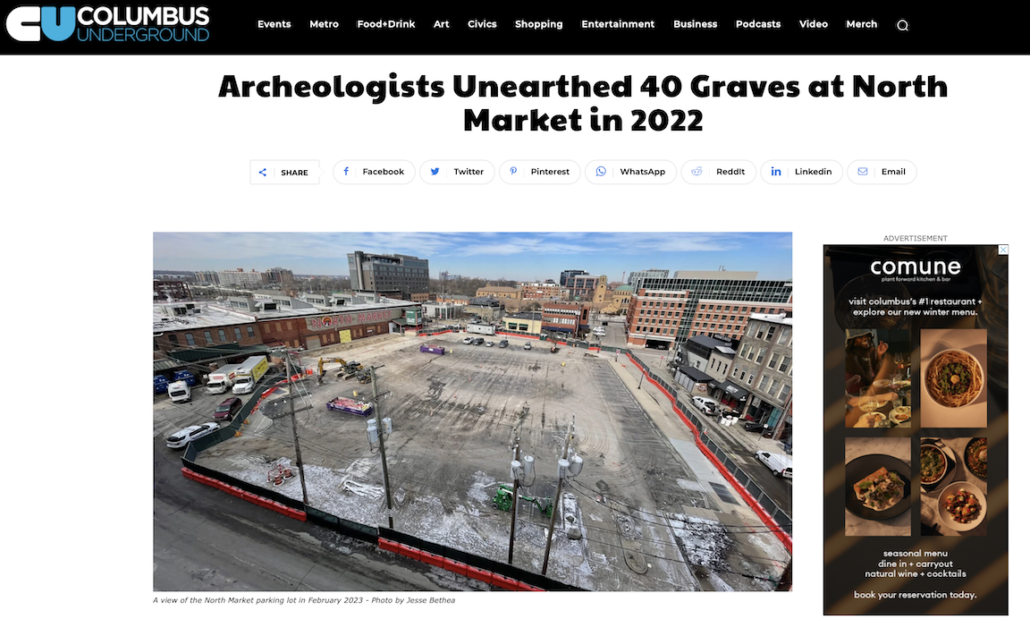
Last summer, a team of archeologists descended on North Market to begin work that should have been finished 150 years before—the removal of human remains from what was once the North Graveyard. In June and July, the environmental consulting firm Lawhon & Associates began excavating the streets surrounding the North Market parking lot, where the development company Rockbridge plans to build the 31-story Merchant Building over the next two years.
That development cannot move forward until the bones have been exhumed.
According to Justin Zink, the Lawhon archeologist leading the project, last year’s initial excavations were part of a city utilities project preparing the infrastructure for Rockbridge’s imminent construction.
“I’m basically working on two separate projects; the Rockbridge project and the city project,” said Zink. “All the excavations to date have been city related.”
As part of the city project, Lawhon archeologists excavated trenches on Spruce Street, Wall Street, Vine Street and Park Street—basically encompassing the four roads surrounding the North Market.
“To date,” said Zink, “We’re at about 40 grave shafts.”
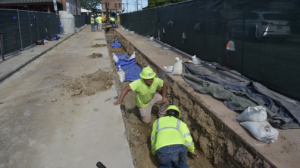
The human remains discovered in those 40 grave shafts—which range from articulated bones to disarticulated bones to mere fragments of bones—currently sit in the Lawhon & Associates building on King Avenue, waiting for osteological analysis by Dr. Cheryl Johnston, an anthropologist and co-founder of the Grave Matters Group. That analysis is expected to reveal many things about the bones and their previous owners, including how many different individuals were buried in those 40 grave shafts. At the moment, the only thing Zink knows for sure is that his team has dug up the remains of more than 40 people.
Krista Horrocks, an archeologist for the State Historic Preservation Office, is the lead reviewer for the North Market development project. Under federal law, government agencies like SHPO must supervise projects that might impact cultural resources, including historic cemeteries. Horrocks, a cemetery specialist, said that in excavations like this one, archeologists will try to determine the MNI—the minimum number of individuals.
“We might find what appears to be one burial shaft, but then when you remove all the human remains and you do osteological analysis you realize that you actually have kind of a jumble or multiple sets of human remains in that one burial,” said Horrocks. “That can happen from any kind of historic or modern disturbance of the area. So we know historically that what is the North Market parking lot now had other buildings sitting atop it at other times.”
For the last century and a half, people have been building, demolishing and rebuilding on the land that was once the North Graveyard. Sewer lines and electrical cables went into the ground, foundations were built and concrete was poured and sometimes graves were shoved into one another. The graves themselves are not very deep—in some places, bodies lie just about a foot beneath the surface of the streets or the parking lot.
“We say people are buried six feet deep,” said Horrocks. “That’s not really accurate, especially historically not very accurate. Six feet is a very deep hole for somebody to dig by hand. But also…the ground had been probably removed at some point, stripping for different kinds of urban development…They were probably buried at least two, three, four feet deep, but now the burial only sits a foot below the ground.”
And because the bones are so close to the surface, it’s long been an open secret in Columbus that the dead sometimes appear uninvited.
“There’s rumors and stories of other remains being found over time,” said Horrocks. “Pretty much any time you stick a shovel in the ground out there you’re gonna find somebody.”
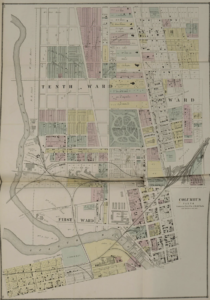
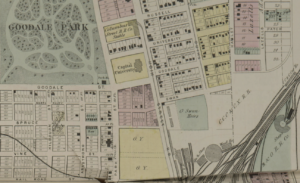
When completed, the Merchant Building will be a 31-story tower looming over High Street, with 174 residential units, 65,000 square feet of office space, a 162-room hotel and a 350-space parking garage. It will be constructed with $34 million worth of assistance from the State of Ohio thanks to the Transformational Mixed-Use Development tax credit program. It will also sit atop the last, relatively undisturbed portion of the old North Graveyard. But no one knows exactly how many graves are left to be discovered.
In October 2021, Dr. Kevin Nolan of the Applied Anthropological Laboratories at Ball State University conducted a ground penetrating radar survey on certain sections of the North Market parking lot. Neither decayed wooden coffins nor human remains would have been visible to the radar, but Dr. Nolan’s survey did identify dozens of anomalies which were “inconsistent with being related to the known historical buildings.”
“All the buildings and other disturbances have different orientations and structures,” wrote Nolan in his report to Lawhon & Associates. “The only pattern of land use that can explain the observed reflections is the distribution of cemetery plots.”
Dr. Nolan identified three potential columns of grave shafts, with a total of 50 individual grave shafts, all within the relatively small area of the parking lot he surveyed.
“Fifty grave shafts should be viewed as a minimum number of potential grave-related features,” warned Dr. Nolan. “There could be as many as 27 additional grave shafts within the subareas.”
Intact graves, in Nolan’s opinion, will likely be “ubiquitous” in the “high probability area”—a portion of the parking lot approximately a 0.4-acre in size relatively undisturbed by historical construction.
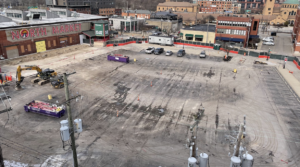
The last time a truly professional excavation of the North Graveyard was attempted was in 2001, when a city sewer project had to be halted while a team of archeologists exhumed 36 individuals from 38 grave shafts at the edge of the North Market parking lot. In a work plan developed in May 2022, Lawhon & Associates extrapolated data from the 2001 excavations, as well as information put forth by Don Schlegel in his influential book The City Graveyards of Columbus, and predicted that it might be possible to encounter anywhere from 142 to 523 graves still retaining human remains.
Randy Rogers, executive director of the Green Lawn Cemetery Association, predicted an even higher number.
“We expect them to uncover upwards of maybe 690 graves, but what they actually find in those graves may not amount to very much in terms of volume,” said Rogers.
As the Merchant Building development progresses, whatever human remains are exhumed will ultimately be reinterred at Green Lawn Cemetery—reinterments that were supposed to happen 150 years ago. There’s even an entire section of Green Lawn devoted to reburials for residents of the old North Graveyard, still waiting for those who were left behind.
“It’s something that we always keep our ear to the ground for any kind of construction or development going on in that area, because whenever there is, we kind of expect that there’s gonna be a need for us to be involved and help be part of the solution,” said Rogers. “The families and friends of those folks are here and so we feel that we should always be available for new remains to be brought here.”
From 1813 to 1864, the North Graveyard was the primary burying ground for the city, and it’s possible that almost 8,000 people were interred there. By the 1870s, however, the cemetery faced pressure from those who wanted to use the land for development and those who felt the presence of a graveyard in the middle of the city was unsanitary and embarrassing.
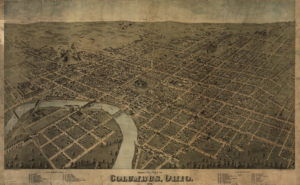
In early 1872, advertisements began to appear in local newspapers like the Columbus Daily Dispatch and the Ohio State Journal. Anyone with a burial lot in the North Graveyard needed to report to the city engineer, because graves in the southern portion of the cemetery were about to be exhumed for a new railroad running across High Street to Union Depot, where the Convention Center is today.
“All others having friends or relatives buried in said graveyard are also notified to designate the names of persons so interred and the location of their graves,” said the ads.
“When you do these news articles and say, ‘Hey, come get your dead, come tell us where your ancestors are buried so we can move them out to Green Lawn,’” said Horrocks, “You were not accounting for disenfranchised communities, minority communities, immigrant communities that were just coming through Columbus. Maybe they had a child die while they were here, they buried them, they moved on. They had no idea that 20 years later the cemetery was saying, ‘Yeah we’re gonna come dig up your kid and move them to Green Lawn, you’d better come tell us where they’re at.’”
It’s not just children who might have been forgotten during the exhumations. One section of the North Graveyard was designated for “strangers”—people without family who would be buried at the city’s expense—and according to Schlegel’s book, the Columbus City Council ordered in 1841 that “the Colored People be buried under the Direction of the North Sexton, and in the same manner that Strangers are buried.” Black people, therefore, were not allowed to purchase family lots and had to be buried in single graves alongside paupers and strangers in the most undesirable portion of the graveyard.
Now, Lawhon & Associates speculates that a valuable avenue of research with regard to the graves left to be excavated will be to determine if class and ethnicity influenced who was taken to Green Lawn and who was left behind.
“That’s a very good guess, is that we’ll see a lot of minorities and we’ll see a lot of children,” said Horrocks. “They weren’t able to be accounted for and they were forgotten.”
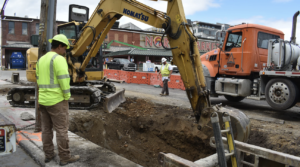
After clearing a portion of the graveyard for the railroad in 1872, there was no going back. Nine years later, in 1881, the work to clear the rest of the North Graveyard began in earnest. The process was industrial and certainly not up to the standards practiced by modern archeologists. Laborers dug trenches two feet wide and five feet deep and shoveled whatever remains and bone fragments they uncovered into shoe boxes, exhuming 867 graves in just about a month. The work was quick and sloppy, and they probably missed a lot.
“It’s unfortunate,” said Horrocks. “But what’s nice about this project is that we’re kind of finally gonna do the right thing and finally try to get as many of these people out as we can to be properly reinterred elsewhere, like they should have been.”
“History is history. We can’t undo history, we can only try to correct the ills, make things better into the future,” said Zink. “So obviously you feel a little bit of that weight to help rectify something that wasn’t handled properly, historically.”
According to Zink, all Lawhon & Associate archeologists are reminded that the bones they exhume were put into the ground by someone’s family members.
“You may be the first person to have seen this individual since their family members laid them to rest in their final resting place,” said Zink. “So be as respectful as possible…do unto others as you would have them do unto you.”
Luckily, said Zink, archeology has changed a lot just in the last decade or so. New archeologists are trained with a strict focus on ethical standards, especially as it concerns human remains and burial grounds. In the coming months and years, that focus will be essential as the archeologists accomplish—or at least, attempt to accomplish—what should have been done 150 years ago.
“It does feel like ” said Zink. “And I don’t think of ‘end’ as a negative. I see it as a positive, it is something that’s been there for this long in this area of the city that is finally getting its due…The final chapter is kind of being written for the North Graveyard with this work. So you definitely get a sense of that and you know you also get a sense that, you know, it’s been a long time coming.”
“It is now our job,” said Zink, “to get them to their new final resting place.”